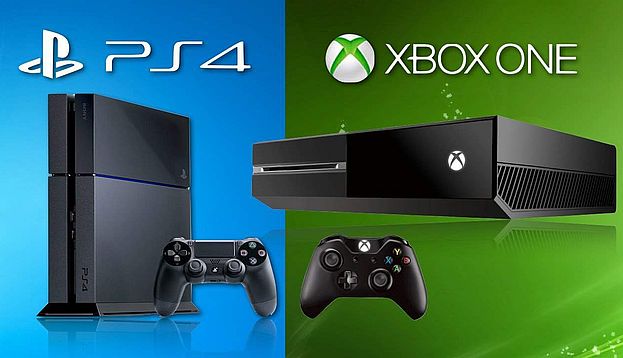Console gaming has entered a new generation of devices, the eighth according to NPD. We enter 2015 with more than a year’s availability for the PlayStation 4 and the Xbox One, and the Wii U has been out for more than two years. So far, the launch of a new generation of consoles has seen a complete shuffling of roles. For the last generation, Nintendo was the clear leader with the Wii, with over 100 million consoles sold; the Xbox 360 and the PS3 ended up in roughly a tie after the Xbox 360’s early lead (83.7 million Xbox 360 consoles, 80 million PS3 consoles). This time, Sony is clearly leading with 13.5 million PlayStation 4 consoles sold, with Microsoft in second place at 10.5 million Xbox Ones and the Wii U trailing with 7.6 million consoles sold.
Still, NPD noted in its most recent report that the Xbox One and PS4 together are well ahead of the last generation of consoles at the same point in their lifecycle. What’s lagging behind is retail sales of the software, and while digital sales are helping, there’s still a nagging deficit. One good indivator of what’s going on this year is to note that for the third straight year in a row, the latest Call of Duty title has sold fewer units than the previous year — and yet it’s still the best-selling console title of the year.
So it’s with this landscape in mind that console game publishers and industry observers are looking at 2015 to see what the new year will bring. The [a]listdaily offers some insight into the important trends in the console game business for 2015, and what you can expect to see. Many decisions will have to be made in the new year, and these are the important trends to keep in mind as you help shape the game industry’s future.
More Downloadable Content Than Ever Before
When the last generation of consoles became the first to expect an Internet connection, the concept of downloadable content for console games really began to take off. It seemed like a natural idea: Add a few maps, or some levels, or some other form of content to an existing game as a simple download for a low price. Best of all, the cost of goods was gone, and no pesky retail discount need get in the way of reaping maximum profits. So a few games began to get the occasional piece of downloadable content or DLC.
Now the situation has changed. It’s a rare game, at least for Sony and Microsoft platforms, that doesn’t have DLC of some kind. Most major titles ship with additional DLC available, either as a free exclusive for a retailer, or even some additional content you can buy right away. DLC is planned for years advance, and you can expect new content to drop at least quarterly, perhaps bimonthly – and monthly in some cases.
We’ll see this trend accelerate as publishers look to extract more money from fans without raising the retail price of the basic game. Expect more different types of DLC, and a variety of price points. We’re now seeing “season passes” being sold to the DLC for the next year, and there will probably be more experimentation with pricing, content, and marketing to find the optimum mix.
This will have an effect on hard drive space, though. While 500 GB may have seemed like a lot, it’s quickly going to fill up. Microsoft has already introduced a 1 TB Xbox One, and we can expect to see other models of consoles appear with higher storage. Add-on drives may get a major push by console makers in order to make more DLC sales possible.

More Price Erosion
GameStop president Tony Bartel was right to warn that bundling games with consoles may negatively impact customer’s willingness to pay full retail for games. But that’s not the only factor at play. PlayStation Plus gave away over $1300 worth of games last year for a $50 subscription, and Xbox Live Gold gave away over $500 worth of games. More and more terrific indie games are appearing on consoles with price points in the $10 to $20 range. All of this has the effect of making gamers wary of paying $60 for a new game – why spend top dollar when there are plenty of fun alternatives for far less, or even for free
That’s not the only source for price erosion in console gaming. Many top PC online games are free with terrific quality, like League of Legends. Free-to-play games already have a beachhead on consoles (like Warframe) and we’ll see more of those appear. The vast and growing array of mobile games are amost all free-to-play, and they have the added advantage of being portable as well. All of this makes it harder to justify the $60 price point for new console games, forcing them to be higher quality with better marketing or risk lower sales.
More Mobile Influence On Console Games
Now that mobile games have become the industry’s largest sector, it’s not hard to understand why this fact will influence console games. This influence has already been happening. For instance, mobile games have to get you playing quickly and engage you rapidly, otherwise you’re onto the next game with a quick tap. This is influencing console games to get you up and playing faster – those lengthy 15 or 20 minute intro videos and hour-long tutorial levels are looking pretty slow and dated. Expect console games to strive harder to get players into the action as quickly as possible.
We’re also going to see more mobile companion apps that link into console games, at least on the PlayStation 4 and Xbox One. Other than sheer graphics horsepower, that’s a key differentiating feature of the new consoles that designers have yet to fully explore. Expect that some sort of mobile companion app will become standard for any major console game release, and possibly stand-alone games that connect with the console games in some way.
More Digital Sales
It’s not just DLC that publishers will be pushing in their quest for more revenue and profits. Full digital game downloads are now not only possible, they are being marketed with increasing frequency for the newest consoles. Publishers are already reporting digital full game sales at anywhere from 10 percent to 20 percent of the retail sales, and we can expect that number to rise. This will tie in with other trends, as the temptation to discount becomes stronger (why not There’s no cost of goods, and what matters is overall revenue, right ) and continues the atmosphere of price erosion and the pressure to add more storage space.
The Continuing AAA Struggle
All of these trends continue to put pressure on the top AAA console games to perform. Budgets are rising, and the time it takes to create these games is still two to three years despite the increasing power of the tools available. That’s partly because publishers feel the need to put ever more content into these games, and expand the range of what players can do in the games, in order to make sure each game is going to be a hit.
Thus investment in each AAA title climbs, and so does the risk. When you extend the trend lines, the end result isn’t pretty. At some point something has to give. What seems logical is that, like blockbuster movies, some brands will be able to carry a huge investment of time and money and make it back with a high level of assurance. Smaller brands, and new IP, will get even riskier if they are expected to have the same sort of budget. Publishers may start looking at smaller size projects, sold only digitally for $20 to $30, than can be created with far lower investment. Then, if it succeeds, produce more content. If it fails, shrug and move on to the next title.
The console market hay not get any larger than the last generation, but publishers are certainly looking to make it at least as profitable as the last generation. When we get the results in from this holiday quarter, we will have some idea of how well publishers are succeeding in reaching that goal.

